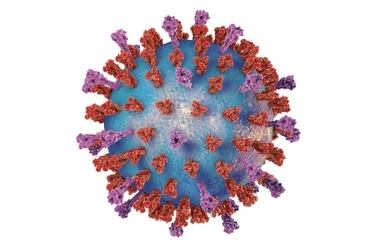Enzymatica science
ColdZyme has been the subject of extensive research, including both in vivo studies (clinical human studies) and in vitro studies (laboratory models mimicking clinical setting). Below, the key findings from the latest studies are highlighted, showcasing the benefits of the ColdZyme barrier, i.e. how it protects against viruses causing common cold/upper respiratory tract infection symptoms, how symptoms are alleviated, and how episode duration is shortened. The in vitro studies demonstrate the effective mechanism behind the benefits of the device, i.e. a protective barrier, where the epithelial integrity is maintained, and the number of viruses that can infect are reduced.
ColdZyme study highlights
Clinical data
An independent, investigator-initiated study at the University of Kent reported significantly lower symptom rating scores and fewer sick days due to upper respiratory tract infections (URTI) in athletes using ColdZyme.1 In this placebo-controlled, double-blind study, 154 elite athletes in endurance sports such as triathlon, marathon and cycling were randomized to treatment with ColdZyme® or placebo. Furthermore, it was shown that ColdZyme reduces viral load by 94% compared to placebo in individuals with rhinovirus caused common colds. Rhinoviruses have been found to be the most frequent cause of the common cold which is one type of upper respiratory tract infection.2
The study is registered on the British Clinical registry platform ISRCTN; https://www.isrctn.com/ISRCTN18133939

The figure illustrates how the ColdZyme barrier protects airway epithelia from virus infection.
ColdZyme vs Placebo
- lower viral load
- lower symptom ratings
- shorter episode duration
A presentation by professors Davison and Wilflingseder on the data published in The Journal of Physiology, Feb 20251:
In vitro
The findings in the clinical study were complemented by in vitro tests conducted using mucus-producing, and ciliated human airway epithelial cells in a model mimicking part of the human respiratory tract.1 Cells were treated with ColdZyme, or control, before rhinovirus infection. Viral load was significantly lower (median reductions 80–100%), epithelial integrity better maintained, and no virus was detected by immunofluorescence analyses, with ColdZyme treatment. Each of these outcomes was statistically significant (p < 0.05).
In addition, studies using other in vitro models have shown that ColdZyme disables a range of respiratory viruses that typically cause common cold and flu, including rhinovirus, respiratory syncytial virus (RSV), adenovirus, influenza virus and coronavirus.1, 3-6
ColdZyme disables majority of viruses that cause the common cold.
| Virus | Percent disabled by ColdZyme3,4 |
|---|---|
| Rhinovirus Type 1A | 91.7% |
| Rhinovirus Type 42 | 92.8% |
| Coronavirus | 99.9% |
| Influenza virus | 96.9% |
| Respiratory Syncytial Virus (RSV) | 99.9% |
| Adenovirus | 64.5% |

The Enzymatica research journey
Numerous clinical and in vitro studies have been performed over the years supporting the clinical benefits of ColdZyme and showing the effective device mechanism behind these benefits.
ColdZyme product development
Development is guided by an in-house team, with input from partners, and support from scientific advisors. In addition, Enzymatica supports independent investigator-initiated research projects at several universities. In the last years, work was intensified with university researchers to investigate the function of ColdZyme against upper respiratory viruses.
Scientific advisors
Enzymatica works with different scientific advisors that are established, well-known researchers in fields such as upper respiratory tract infections. They assist Enzymatica in research-related issues and advise on future research and product opportunities. Enzymatica has a professional agreement with Professor Charles S Craik.
Charles S Craik is a world-renowned scientist that serves as a professor at the Department of Pharmaceutical Chemistry at the University of California, San Francisco (UCSF). His research focuses on chemical biology and enzymology, with an emphasis on proteolytic enzymes, receptors and membrane transporters. He studies the functions and mechanisms of enzymes in complex biological systems and contributes to the development of technologies aimed at rapid detection, monitoring, and control of infectious diseases and cancer. Professor Craik advices Enzymatica on research-related issues, future research and product opportunities.
References
- Davison, G. et al. ColdZyme® reduces viral load and upper respiratory tract infection duration and protects airway epithelia from infection with human rhinoviruses. J Physiol (2025). https://doi.org/10.1113/jp288136
- Heikkinen, T. & Jarvinen, A. The common cold. Lancet 361, 51-59 (2003). https://doi.org/10.1016/S0140-6736(03)12162-9
- Stefansson, B., Gudmundsdottir, Á. & Clarsund, M. A medical device forming a protective barrier that deactivates four major common cold viruses. Virology: Research & Reviews 1 (5), 1-3 (2017). https://doi.org/10.15761/VRR.1000130
- Gudmundsdottir, Á., Scheving, R., Lindberg, F. & Stefansson, B. Inactivation of SARS-CoV-2 and HCoV-229E in vitro by ColdZyme® a medical device mouth spray against the common cold. Journal of medical virology 93, 1792-1795 (2021). https://doi.org/10.1002/jmv.26554
- Posch, W. et al. ColdZyme Maintains Integrity in SARS-CoV-2-Infected Airway Epithelia. mBio 12 (2021). https://doi.org/10.1128/mBio.00904-21
- Zaderer, V. et al. ColdZyme® protects airway epithelia from infection with BA.4/5. Respir Res 23, 300 (2022). https://doi.org/10.1186/s12931-022-02223-2